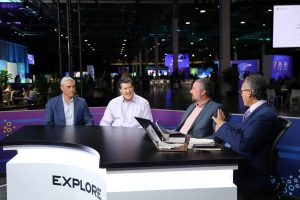 CLOUD
CLOUD
 CLOUD
CLOUD
 CLOUD
CLOUD
A decade ago, public cloud was the de-facto standard, promising scalability, flexibility and cost savings. Given the explosion in data volumes and proliferation of workload types, companies are now reassessing cloud strategies and moving select workloads to private and hybrid clouds.
What’s the root cause of this seismic shift,and how will it impact artificial intelligence operations?

Discussing cloud strategy with Broadcom’s Mike Gannon and IDC’s Stephen Elliot.
“We saw that there was some labor shortages in the lift and requirements to get some traditional applications there,” said Mike Gannon (pictured, left), president of North America at Broadcom Inc. “We started recognizing some cost concerns around once the application was there, was it the most efficient place to run it? We’re starting to see a rebalancing of what is the appropriate workload to run at the cloud.”
Gannon and Stephen Elliot (right), group vice president at International Data Corp., spoke with theCUBE Research’s Dave Vellante and Rob Strechay at VMware Explore, during an exclusive broadcast on theCUBE, SiliconANGLE Media’s livestreaming studio. They discussed the strategic pivot in the cloud industry to balance cost, control and innovation as companies increasingly turn to private and hybrid clouds. (* Disclosure below.)
Enterprises now recognize that a one-size-fits-all approach to the cloud is unsustainable. Instead, they are looking at private clouds as a way to regain control over their IT environments. Within Broadcom, for example, VMware delivers cloud experiences on-premises, which allows organizations maintain the flexibility of the cloud while keeping critical workloads closer to home, according to Gannon.
“That’s an exciting concept because the IT practitioners who have optimized applications on current data centers are now part of the cloud experience,” he said. “Whereas in the past, it was the developer ran off and they wanted to start optimizing the app, but the IT wasn’t really involved in the decision-making. We’re seeing this repatriation of not just workloads, but the talent pool that’s now supporting this cloud experience.”
Cost efficiency and resiliency are now top priorities as companies map out their cloud strategies. Anomalous events, such as the 2008 financial crisis and the recent pandemic, forced a rush to public cloud to mitigate large expenditures while supporting remote operations. But recent findings show considerable repatriation of workloads from public clouds back to private clouds within the next year, underscoring the importance of cost management and the need for businesses to optimize their cloud spending to drive profitable growth, according to Elliot.
“The recognition of where to place workloads and how to think about what these workloads mean to their business has elevated at a level we haven’t seen before,” he said. “One of the reasons is you look at COVID and how that’s driven the decision-making relative to how do we leverage the technology architectures to drive our business. We’re looking at opportunities relative to moving workloads back onto private cloud repatriation.”
Technology alone is not enough to drive successful cloud transformations. People and processes are equally critical. By fostering a culture of innovation and continuous improvement, organizations can better adapt to changing market conditions and customer needs, both guests concluded.
Here’s the complete video interview, part of SiliconANGLE’s and theCUBE Research’s coverage of VMware Explore:
(* Disclosure: VMware by Broadcom sponsored this segment of theCUBE. Neither VMware nor other sponsors have editorial control over content on theCUBE or SiliconANGLE.)
Support our mission to keep content open and free by engaging with theCUBE community. Join theCUBE’s Alumni Trust Network, where technology leaders connect, share intelligence and create opportunities.
Founded by tech visionaries John Furrier and Dave Vellante, SiliconANGLE Media has built a dynamic ecosystem of industry-leading digital media brands that reach 15+ million elite tech professionals. Our new proprietary theCUBE AI Video Cloud is breaking ground in audience interaction, leveraging theCUBEai.com neural network to help technology companies make data-driven decisions and stay at the forefront of industry conversations.